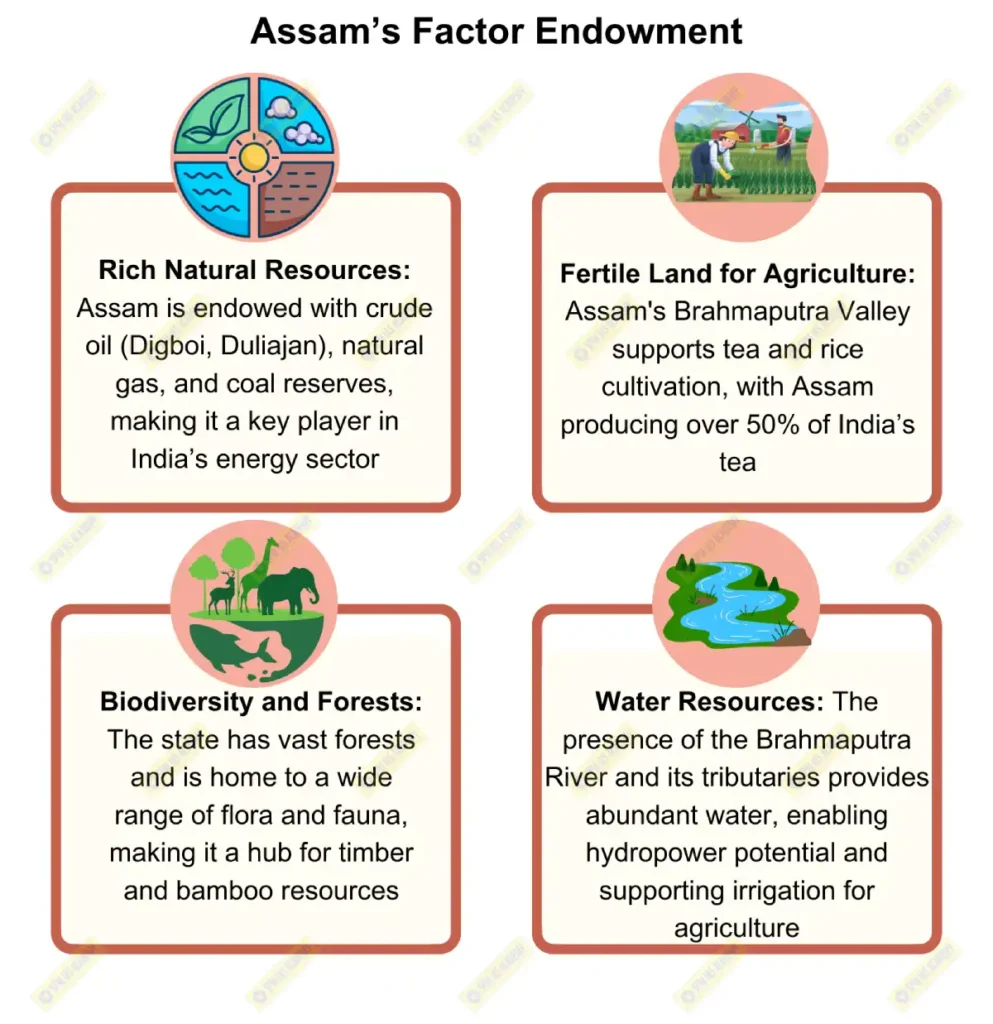Factor endowment, which includes natural resources, labor, and capital, often provides a foundation for industrial development. However, while such endowments can facilitate industry, they are not always sufficient for growth. In the context of Assam, despite its rich natural resources, several challenges hinder industrial development. These challenges underscore that other factors such as infrastructure, governance, policy frameworks, and skilled labor are crucial alongside factor endowments.
Factor Endowment in Assam:
1. Natural Resources:
- Assam is endowed with abundant natural resources like oil, natural gas, coal, and tea. The state produces over 50% of India’s tea and is a significant contributor to the country’s crude oil production, with major oil fields in Digboi, Duliajan, and Rudrasagar.
- Assam’s fertile soil and favorable climate also support agriculture, making it a hub for tea and agricultural industries.
2. Favorable Climate and Geography:
- Assam’s tropical climate is ideal for tea production and rubber plantations. The world-famous Assam Tea industry thrives due to these natural advantages, demonstrating the importance of natural endowments in industrial success.

Challenges Beyond Factor Endowment:
Despite Assam’s rich resources, its industrial development has been slow due to challenges related to infrastructure, human capital, policy, and governance. Various committees and reports have highlighted these issues.
1. Infrastructure Deficit:
- Transport and Connectivity: Assam suffers from a lack of proper road, rail, and port infrastructure, which hampers the movement of raw materials and finished goods. The Planning Commission and High-Level Committee on North Eastern States (Shukla Committee, 1997) stressed the importance of improving infrastructure to unlock the potential of Assam’s natural resources.
- The oil and gas industry in Assam, for example, remains underdeveloped because much of the crude oil extracted is sent to refineries outside the state due to limited refining capacity within Assam.
- The Committee on Infrastructure (2006) also identified that the power supply in Assam is erratic, which affects industries that rely heavily on energy, such as manufacturing and petrochemicals.
2. Human Capital and Skill Development:
- Skill Gaps: The Assam Human Development Report (2014) pointed out the mismatch between the available labor force and the skills required for industrial growth. While the literacy rate in Assam has improved (around 73%), there is a significant gap in technical and vocational training.
- The National Skill Development Corporation (NSDC) highlighted the need for improved skill development programs in the state, particularly in sectors like IT, engineering, and manufacturing, to create a workforce aligned with industry needs.
3. Policy and Governance Issues:
- Regulatory Bottlenecks: The implementation of industrial policies in Assam has faced delays due to bureaucratic inefficiencies and weak governance. The North East Industrial and Investment Promotion Policy (NEIIPP) of 2007 was designed to attract investment by offering tax incentives, but a CAG report (2015) noted that poor implementation and regulatory hurdles limited its effectiveness.
- Additionally, reports from institutions like the World Bank and DPIIT (Department for Promotion of Industry and Internal Trade) emphasized the need for improving the ease of doing business in Assam to attract investment. Challenges like complex land acquisition processes, delays in approvals, and bureaucratic red tape have discouraged industries from setting up operations, even in resource-rich sectors like oil and gas.
4. Market Access and Political Instability:
- Geographical Isolation: Assam’s geographic isolation from the rest of India limits its access to large markets. The Shukla Committee Report (1997) highlighted that poor connectivity with the rest of the country and Southeast Asia hinders the state’s industrial growth. The Act East Policy is designed to improve trade routes, but further infrastructure development is needed to fully integrate Assam into regional supply chains.
- Political Instability and Insurgency: Past issues of insurgency and political instability have dampened investor confidence in the region. Reports from the Home Ministry have acknowledged that prolonged political instability in Assam affected investment inflow and slowed down industrialization.
Success Stories Despite Challenges:
Assam has seen some success where natural endowments have combined with supportive policies:
1. Tea Industry:
The tea industry continues to thrive, thanks to natural endowments like fertile soil and a favorable climate. The Geographical Indication (GI) tag for Assam Tea has helped protect the brand internationally, and government schemes have supported small tea growers.
2. Numaligarh Refinery:
Despite Assam’s infrastructure deficits, the Numaligarh Refinery has emerged as a success story. Established as part of the Assam Accord, this refinery is a key player in the state’s oil industry, showing that when infrastructure and government support align with factor endowment, industrial growth is possible.
While factor endowment is important for industrial development, it is not the sole determinant. Assam’s natural resources offer significant potential, but infrastructure deficits, policy implementation gaps, human capital shortages, and market access issues constrain industrial growth. Reports from committees such as the Shukla Committee and NSDC highlight the need for improvements in these areas. To fully capitalize on its factor endowments, Assam must address these challenges through better governance, infrastructure development, and skill enhancement, thus enabling a more balanced and sustainable industrial growth trajectory.












